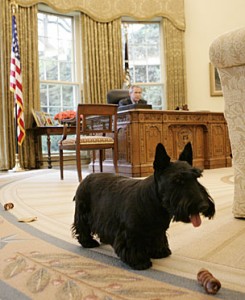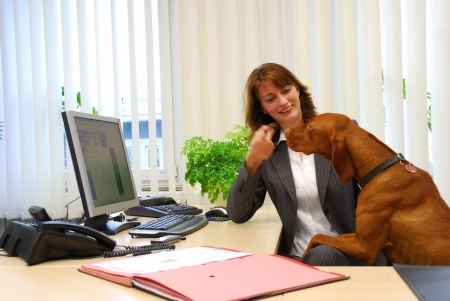May is National Pet Month. All month, pet stores, veterinarians and animal shelters will extole the virtues of owning and caring for pets. Pet lovers have long understood the benefits of pet ownership. Finally, it seems that businesses are catching onto and hoping to capitalize on those benefits. From the corner office to the Oval Office, well-behaved pets help reduce stress, force crazy-busy executives (and U.S. Presidents) to go for a periodic walk, and keep employees who work long hours happier and less worried about their beloved, furbabies.
Many companies that allow pets are in the pet business, Purina for example, but there are a growing number of non-pet-related companies, both large and small, embracing pets in the workplace. While dogs are the most predominant pets at work, some companies do allow cats and other creatures. Companies, like Google, define themselves specifically as a“dog company” in their conduct policies: “Google’s affection for our canine friends is an integral facet of our corporate culture. We like cats, but we’re a dog company, so as a general rule we feel cats visiting our offices would be fairly stressed out.” While forward-thinking Google might not seem odd on a list of pet-friendly companies, Ben & Jerry’s just might. Ben & Jerry’s allows dogs in the office (thankfully, not in production areas) where they roam through the creative department and seem to inspire some fantastic ice cream flavors. Even Amazon has joined the dog friendly bandwagon, provided the dogs are vaccinated and on a leash or behind a gate.
Before you assume that pets at work would encourage a fur-filled free for all, look at the reality. While there certainly can be mishaps, most companies with which we spoke have a plan in place and take their pet-friendly workspaces very seriously.
Trupanion is a medical coverage provider for pets that has been a pet-friendly company since its inception, when it was just the Founder, Darryl Rawlings, and his dog, Charlie. The company has grown to 320 employees and 90 pets (including both cats and dogs). “We currently have a 1:3 pet to employee ratio-one of the highest in the country (maybe the highest by now). The success of Trupanion’s pet-friendly office relies heavily on an established pet policy developed over the years,” said Kathryn Clappison, public relations coordinator.
Clappison also said, “Trupanion welcomes all dogs and cats, as long as they are well-behaved and abide by the rules. Trupanion has a designated Pet Team of employees, including those with veterinary practice and pet care facility experience such as veterinarians and certified veterinary technicians, who provide guidance and review pet incidents. All of Trupanion’s employees have a clear understanding of the office pet rules, which apply equally from interns to executives.”
In addition to increased employee satisfaction and retention, decreased stress, and a positive work environment, the pets foster in-office relationships every day. However, employees must follow strict guidelines to maintain a productive working environment when bringing pets into the workplace. Policies and pet owners must consider pet health and safety and minimize distractions.
“Office petiquette” is extremely important, Clappison said. “Employees who bring their pets to work minimize distractions through obedience training to keep dogs calm and quiet, silencing squeaky toys, and maintaining coworkers’ personal space. The pets at Trupanion are always secured by baby gates or tethers and are always under human supervision. They must be up to date on vaccinations and pet owners are offered advice on how to keep pets safe and well behaved during the workday.” Pet owners must immediately clean up any accidents, and Trupanion offers cleaning resources to do so. Trupanion provides free pet healthcare coverage to Trupanion’s  employee-owned pets and provide free dog walking services throughout the day to give pets a break from the 9-5 grind. The company even has a fire-safety plan for pets at the office.
employee-owned pets and provide free dog walking services throughout the day to give pets a break from the 9-5 grind. The company even has a fire-safety plan for pets at the office.
Dana Kaye, owner of Kaye Publicity, a boutique PR company specializing in publishing and entertainment, said, “We are a dog-friendly office, and I bring Mrs. Dalloway, my shih-tzu poodle, to work almost every day.” The employees love Mrs. Dalloway and she’s a great morale booster on tough days.
They are training her to bring in the mail but so far, “she brings it halfway across the office and leaves it under a conference table.” Another coworker at Kaye Publicity volunteers with PAWS and fosters shelter dogs, so she occasionally brings in the pups. Kaye added, “It gets rowdy, but having dogs arounddefinitely makes for a less stressful work environment.”
Dogs in the office are not without mishaps. Some employees have reported the occasional sandwich missing from the breakroom or having to dodge the unexpected warm pile, a near miss under a beautiful pump. Kelly Costello, Owner and Founderof Puppy Cake LLC, manufacturer of specialty dog treats like cake mix for dogs, does allow dogs at work in their small office. They have had as many as four dogs at a time in the tiny office. They had to adapt their policy to allow only older, better-trained dogs after a mishap with an employee’s 1 ½ year old Bernese mountain dog. The dog pooped in the office within the first hour at work, and “the employee knew the dog had a bad habit of pooping in ALL new environments.”
Other companies bring dogs who actually “work” at the office. Susanna Linse, Vice President of Marketing at Tiger Tail USA, called the ability to bring her dog to work the “best benefit I’ve ever received.” She brings her dog to work almost everyday, but her dog Petey does have to earn his keep. Petey and the owner’s dog, Desmo, perform unofficial quality control for Tiger Tail on muscle massage products they manufacture. The dogs answer questions, Linse said, such as “Can they chew the ball? Can they tear off the rope?” When he’s not “working”, Petey “likes to sunbathe and sleep on his back with his legs stuck up in the air.” Truly, a dog’s life.
If you intend to bring your pet to work, here are some tips to make the experience more enjoyable for everyone:
Establish policy. Create guidelines for the workplace to govern both animals and owners. Be cognizant of allergies, necessary clean up, and what areas will be off limits to pets.
Give your pet its own space. Setting up a bed or crate for your dog or cat will make it feel safe. When you establish its location, you reduce the likelihood of the pet staking claim to its own locale and becoming territorial.
Be a responsible pet parent. Supervise your pet. Be respectful of coworkers by making sure your dog is well behaved. Barking, growling and whining can be very distracting to coworkers. Make sure your pets are healthy, free of fleas and up to date on vaccinations. The last things you want to share at the office are pet diseases.
Bring only housebroken pets to work. You might not mind cleaning up after Mr. Piddles at home, but the office is no place for those with chronic accidents. Walk your dog frequently, or if you bring your cat to the office, clean its litter box frequently to avoid noxious odors wafting through the ventilation to the breakroom.
If there are other pets in the office, help them to socialize with each other for short periods. Pet tension might lead to employee tension.
TAGS: Pet Month Workplace
 Interviewer Interview Prep
Interviewer Interview Prep Impactful Mentees
Impactful Mentees Benefits of a Mentor
Benefits of a Mentor Advice for First-Time Managers
Advice for First-Time Managers Overcoming the 18-month Itch
Overcoming the 18-month Itch Dressing for Your Style
Dressing for Your Style Interview Style Tips
Interview Style Tips Women's Stocking Stuffers
Women's Stocking Stuffers Gift the Busy Traveler
Gift the Busy Traveler Father’s Day Gift Guide
Father’s Day Gift Guide Airport Layover Activities
Airport Layover Activities Traveling & Eating Healthy
Traveling & Eating Healthy Travel Like a Boss Lady
Travel Like a Boss Lady The Dual California Life
The Dual California Life Gifts for Thanksgiving
Gifts for Thanksgiving Summer Reading List
Summer Reading List Top Leisurely Reads
Top Leisurely Reads New Year, New Books
New Year, New Books Life Lessons from a Sitcom
Life Lessons from a Sitcom Oprah, Amy or Amal?
Oprah, Amy or Amal?







